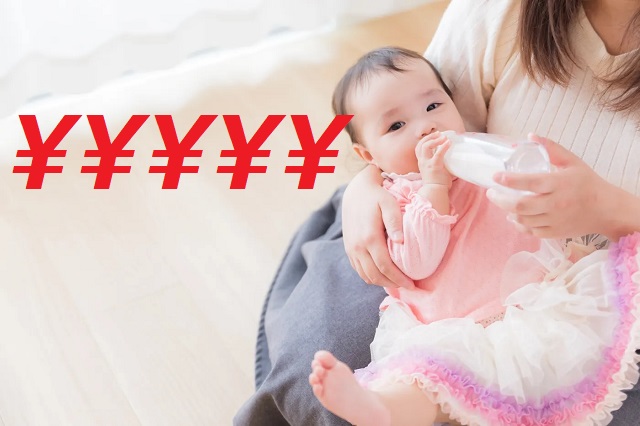
And if you have another kid after that? Another two million yen.
Notice: This article was originally published incorrectly stating that the total grant was 20 million yen. The writer responsible has been whacked upside the head for their negligence, and SoraNews24 sincerely apologizes to anyone who became pregnant before the error was corrected.
Japan’s birthrate has been slumping for decades, and while anyone packed into a crowded Tokyo commuter train might momentarily be fine with the concept of fewer people, long-term it presents problems for Japan’s pension, health insurance, and other social welfare and economic systems.
Because of that, both the national and local governments are constantly investigating new initiatives to encourage people to start cranking out more kids, and the latest plan from the city of Sado, Niigata Prefecture, is to give parents two million yen (US$18,180) for having a third kid, and also for each additional kid after that.
That’s not to say that a city official shows up in the delivery room with a stack of 200 10,000-yen bills, though, since the grant is meant to help with the costs of both child rearing and education. The parents receive a payment of 200,000 on the occasion of the child’s birth followed by sums of 400,000, 500,000, and 800,000 yen when they turn 6, 12, and 15 years old, roughly aligning with the ages when they start elementary, middle, and high school (as high school is not part of compulsory education in Japan, even public high schools charge tuition). Combined with a separate Sado program started earlier in the year that gives a 100,000-yen grant for any birth in the city, the total payment for each third or later child comes out to two million yen.
▼ “You’re welcome, Mom and Dad.”
But why start the surge at the third child? Because of the results of a survey Sado conducted last year among households in the city who already have children, which asked them how large of a family they’d ideally like. More than half of the respondents said they’d like to have three kids, but many also said that such a large family would be economically difficult for them.
Sado’s strategy of focusing on families that already have children makes a certain kind of sense. As Japanese lifestyles continue to evolve and become more diverse, there’s comparatively less social pressure to have children than there was in previous generations, and thus a larger number of people who simply aren’t interested in having kids of their own. Respecting their freedom to make that choice, and instead concentrating on couples who’ve already decided they want to be parents but are hesitant to expand their brood because of budgetary concerns, sounds like a win-win.
On the other hand, one could argue that waiting until the third child for the major economic support to kick in makes it harder for childless couples to make that first, or even second, step into parenthood, and that spreading the benefits more evenly among births could lower that entry barrier.
Still, for couples who would like big family, two million yen is a lot of money, and Sado hopes that the program not only promotes births among its current households, but also helps convince people from other parts of Japan to move to the city and raise their children there. And if nothing else, it sounds like a better plan than relying on parental nagging or A.I. matchmakers.
Source: NHK News Web
Top image: Pakutaso (edited by SoraNews24)
Insert image: Pakutaso
● Want to hear about SoraNews24’s latest articles as soon as they’re published? Follow us on Facebook and Twitter!
Follow Casey on Twitter, where he’d like to apologize or not not earning two million yen for his parents at the moment of his birth.


 Tokyo’s latest plan to boost birth rate: Pay people 100,000 yen per baby they give birth to
Tokyo’s latest plan to boost birth rate: Pay people 100,000 yen per baby they give birth to Japanese government to start giving newlywed couples a wedding gift of 600,000 yen
Japanese government to start giving newlywed couples a wedding gift of 600,000 yen You can now buy bully insurance for your kids in Japan
You can now buy bully insurance for your kids in Japan Tokyo makes high school free for all families, even the rich ones
Tokyo makes high school free for all families, even the rich ones Japanese government wants to give people an extra 80,000 yen to have babies, but will it work?
Japanese government wants to give people an extra 80,000 yen to have babies, but will it work? Japanese ramen restaurants under pressure from new yen banknotes
Japanese ramen restaurants under pressure from new yen banknotes McDonald’s new Happy Meals offer up cute and practical Sanrio lifestyle goods
McDonald’s new Happy Meals offer up cute and practical Sanrio lifestyle goods A trip to hell on Japan’s ‘vomit ship’: Is it as bad as everyone says it is?
A trip to hell on Japan’s ‘vomit ship’: Is it as bad as everyone says it is? Sakura tree falls on man at Sannenzaka near Kiyomizu temple in Kyoto 【Breaking News】
Sakura tree falls on man at Sannenzaka near Kiyomizu temple in Kyoto 【Breaking News】 French Fries Bread in Tokyo’s Shibuya becomes a hit on social media
French Fries Bread in Tokyo’s Shibuya becomes a hit on social media New private rooms on Tokaido Shinkansen change the way we travel from Tokyo to Kyoto
New private rooms on Tokaido Shinkansen change the way we travel from Tokyo to Kyoto Secret Kitchen bento serves Japanese flowers, birds, wind and moon in a box, but is it worth it?
Secret Kitchen bento serves Japanese flowers, birds, wind and moon in a box, but is it worth it? Family Mart makes matcha dreams come true with new lineup of strong green tea sweets in Japan
Family Mart makes matcha dreams come true with new lineup of strong green tea sweets in Japan Japanese company starts project to restore Nakagin Capsules to capsule hotel
Japanese company starts project to restore Nakagin Capsules to capsule hotel Fire away your frustration at ‘404 Not Found’ — Site turns error message into classic arcade game
Fire away your frustration at ‘404 Not Found’ — Site turns error message into classic arcade game All-you-can-drink Starbucks and amazing views part of Tokyo’s new 170 meter-high sky lounge
All-you-can-drink Starbucks and amazing views part of Tokyo’s new 170 meter-high sky lounge More foreign tourists than ever before in history visited Japan last month
More foreign tourists than ever before in history visited Japan last month Starbucks reopens at Shibuya Scramble Crossing with new look and design concept
Starbucks reopens at Shibuya Scramble Crossing with new look and design concept Studio Ghibli releases new action figures featuring Nausicaä of the Valley of the Wind characters
Studio Ghibli releases new action figures featuring Nausicaä of the Valley of the Wind characters Studio Ghibli glasses cases let anime characters keep an eye on your spectacles
Studio Ghibli glasses cases let anime characters keep an eye on your spectacles Is the new Shinkansen Train Desk ticket worth it?
Is the new Shinkansen Train Desk ticket worth it? Beautiful Ghibli sealing wax kits let you create accessories and elegant letter decorations【Pics】
Beautiful Ghibli sealing wax kits let you create accessories and elegant letter decorations【Pics】 Studio Ghibli releases Kiki’s Delivery Service chocolate cake pouches in Japan
Studio Ghibli releases Kiki’s Delivery Service chocolate cake pouches in Japan New definition of “Japanese whiskey” goes into effect to prevent fakes from fooling overseas buyers
New definition of “Japanese whiskey” goes into effect to prevent fakes from fooling overseas buyers Our Japanese reporter visits Costco in the U.S., finds super American and very Japanese things
Our Japanese reporter visits Costco in the U.S., finds super American and very Japanese things Studio Ghibli unveils Mother’s Day gift set that captures the love in My Neighbour Totoro
Studio Ghibli unveils Mother’s Day gift set that captures the love in My Neighbour Totoro Domino’s Japan now sells…pizza ears?
Domino’s Japan now sells…pizza ears? New Japanese KitKat flavour stars Sanrio characters, including Hello Kitty
New Japanese KitKat flavour stars Sanrio characters, including Hello Kitty New Pokémon cakes let you eat your way through Pikachu and all the Eevee evolutions
New Pokémon cakes let you eat your way through Pikachu and all the Eevee evolutions Sales of Japan’s most convenient train ticket/shopping payment cards suspended indefinitely
Sales of Japan’s most convenient train ticket/shopping payment cards suspended indefinitely Sold-out Studio Ghibli desktop humidifiers are back so Totoro can help you through the dry season
Sold-out Studio Ghibli desktop humidifiers are back so Totoro can help you through the dry season Japanese government to make first change to romanization spelling rules since the 1950s
Japanese government to make first change to romanization spelling rules since the 1950s Ghibli founders Toshio Suzuki and Hayao Miyazaki contribute to Japanese whisky Totoro label design
Ghibli founders Toshio Suzuki and Hayao Miyazaki contribute to Japanese whisky Totoro label design Doraemon found buried at sea as scene from 1993 anime becomes real life【Photos】
Doraemon found buried at sea as scene from 1993 anime becomes real life【Photos】 Tokyo’s most famous Starbucks is closed
Tokyo’s most famous Starbucks is closed One Piece characters’ nationalities revealed, but fans have mixed opinions
One Piece characters’ nationalities revealed, but fans have mixed opinions We asked a Uniqlo employee what four things we should buy and their suggestions didn’t disappoint
We asked a Uniqlo employee what four things we should buy and their suggestions didn’t disappoint Princesses, fruits, and blacksmiths: Study reveals the 30 most unusual family names in Japan
Princesses, fruits, and blacksmiths: Study reveals the 30 most unusual family names in Japan Japanese town that spent 25 million yen in COVID money on giant squid statue says it paid off big
Japanese town that spent 25 million yen in COVID money on giant squid statue says it paid off big 5 powerful reasons to be a woman in Japan 【Women in Japan Series】
5 powerful reasons to be a woman in Japan 【Women in Japan Series】 Japanese government’s new birth rate plan: Use AI to tell people who’d be a good spouse for them
Japanese government’s new birth rate plan: Use AI to tell people who’d be a good spouse for them Kyoto families angered by new policy forcing high school students to buy tablets at own expense
Kyoto families angered by new policy forcing high school students to buy tablets at own expense Critically acclaimed A-bomb manga Barefoot Gen excerpts removed from Hiroshima school curriculum
Critically acclaimed A-bomb manga Barefoot Gen excerpts removed from Hiroshima school curriculum Top five Japanese prefectures for childhood education expenditure would make any wallet shudder
Top five Japanese prefectures for childhood education expenditure would make any wallet shudder Medical bills to be free in all Tokyo wards for high school students, younger kids from next year
Medical bills to be free in all Tokyo wards for high school students, younger kids from next year “Bully insurance” now on the rise, with many more practical uses than just insuring bullying
“Bully insurance” now on the rise, with many more practical uses than just insuring bullying Japan’s revised child care law makes it easier for fathers to take four weeks of paternity leave
Japan’s revised child care law makes it easier for fathers to take four weeks of paternity leave What’s the minimum amount of money Japanese women want their husbands to earn? Survey investigates
What’s the minimum amount of money Japanese women want their husbands to earn? Survey investigates Japanese politician’s birthrate plan: Have parents nag their kids to have “at least three babies”
Japanese politician’s birthrate plan: Have parents nag their kids to have “at least three babies” Tokyo Tama schools distributing free feminine hygiene products to students
Tokyo Tama schools distributing free feminine hygiene products to students People in Japan are being paid to have babies, and it seems to be working
People in Japan are being paid to have babies, and it seems to be working Japanese teen idol singer impregnated by manager gives birth to healthy baby boy【Photos】
Japanese teen idol singer impregnated by manager gives birth to healthy baby boy【Photos】 Tokyo plan to give 100,000 yen to residents who get infected with coronavirus sparks backlash
Tokyo plan to give 100,000 yen to residents who get infected with coronavirus sparks backlash
Leave a Reply